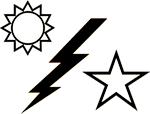A map is a graphical representation of the earth's surface as shown from above and down to scale.
5 Major Terrain Features
(Hidden Valley Ranch Salad Dressing)
- Hill
- Vally
- Ridge
- Saddle
- Depression
3 Minor Terrain Features
- Spur
- Draw
- Cliff
2 Supplementary Terrain Features
- Cut
- Fill
Accuracy of grids given in MGRS: (always read MGRS grids
right and then
up)
4 digit grid accuracy = 1km
6 digit grid accuracy = 100m
8 digit grid accuracy = 10m
10 digit grid accuracy = 1m
Norths on a Military Map
(declination diagram, lower right of military map)
Grid: Grid notrth is a navigational term refering to the direction northwards along the grid lines of a map projection.
True: The direction from an observer's position to the geographic north pole, or the north direction of any geographic meridian.
Magnetic: The direction indicated by the north-seeking pole of a freely suspended magnetic neddle, influenced only by the earth's magnetic field (free from local magnetic influence). It points to an iron ore deposit near Ellemere Island, the northeastern most island of Canada, adjacent to Greenland.
Degrees and MILS
There are 360 degrees in a circle
There are 17.7 mils in one degree and ~6400 mils in 360 degrees.
Minute of Angle (or minute of arcminute)
Equates to 1/60th of 1 degree, and is roughly 1 inch at 100 yards.
MIL
1 mil is the angle formed by a right angle triangle 1000 metres long and 1 metre wide. (6283.2 mils in a full circle: NATO armies rounded up to 6400. Warsaw pact rounded down to 6000 for easier battle arithmetic for Forward Observers).
Intersection:
Finding the location of an unknown point by sighting two or more known points.
Resection:
Resection is the method of locating one's position on a map by determining the grid azimuth to at least two well-defined locations that can be pinpointed on the map.
Compass Methods of Hold:
Center-hold method: -5 degrees margin of error(night option)
Compass to cheek weld method: -1 degree margin of error(best daytime)
LARS(Left-add, Right-subtract)
On the declination diagram, place your finger on the north line that you have. Move your finger to the North line to which you are converting. (If your finger moved left, add the difference, if your finger moved right, subtract the difference.)
Colors on a Military Map
Black - Indicates cultural (man-made) features such as buildings and roads, surveyed spot elevations, and all labels.
Red-Brown - The colors red and brown are combined to identify cultural features, all relief features, non-surveyed spot elevations, and elevation, such as contour lines on red-light readable maps.
Blue - Identifies hydrography or water features (lakes, swamps, rivers, drainage).
Green - Identifies vegetation with military significane (woods, orchards, vineyards).
Brown - Identifies all relief features and elevation, such as conturs on older edition maps, and cultivated land on red-light readable maps.
Red - Classifies cultural features, such as populated areas, main roads, and bounderies, on older maps.
Other - Occasionally other colors may be used to show special information. These are indicated in the marginal information as a rule.
Common Land Navigation Techniques
Strong point, hand rail, back stop, pace count.
Common Land Navigation Errors
Errors compound on each other! Reading the Grid incorrectly, or not reading rihgt and up, plotting the grid point incorrectly(use small mark and check twice), reading the line plotted from one point to the next incorrectly(degree ring, not mils), Using LARS formula incorrectly(oposite) and creating double the built-in error, not weaving to opposite side as you walk through trees(you will favor one direction), not knowing your pace count - walking in easy and difficult terrain and running.
